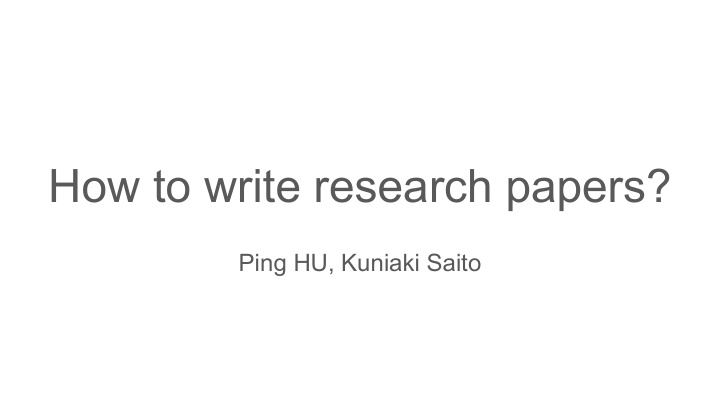



How to write research papers? Ping HU, Kuniaki Saito
A paper’s impact on your career
Our image of the research community ● Scholars, plenty of time on their hands, pouring over your manuscript.
The reality: more like a large, crowded marketplace
Content ★ Before Writing ★ How to Write ★ After Writing
Before writing a paper ➔ Choose a topic How to choose topics? ● Your own interests. ● Advices from supervisor. ● Follow the community's hot topics.
Before writing a paper ➔ Literature review How do you reading papers when you write papers? - Abstract - Introduction - Related work - Experiments - Methodology - Conclusion - Future works - References
Before writing a paper ➔ Experiments & Writing Manage your work progress - Experiments first? - Writing first? - At the same time?
Before writing a paper ➔ Write for submission ● Choose a journal/conference/workshop to submit your paper. ○ Area & Preference ○ Reputation & Accepting rate ○ Timeline ○ Page limit ○ Format requirements ○ Page Charges ...
Content ★ Before Writing ★ How to Write ★ After Writing
Structure of a paper ● Title, Abstract 1, Which parts should we spend time the most? ● Introduction 2, Which parts should we start to write at first? ● Related Work ● Method ● Experiment ● Discussion, Analysis ● Summary, Future Work
Structure of a paper ● Title, Abstract Spend the most time, start with here! ● Introduction ● Related Work ● Method Depends on paper, journal, conference... ● Experiment ● Discussion, Analysis ● Summary, Future Work
Review: Aspect of a good paper ● Novelty ● Presentation ● Originality ● Application ● Educational (Based on journal or conference)
What should we keep in mind in writing a paper? ● We propose something. ? ● Others did not do it. ● We did something. ● We did experiments, ours was better.
What should we keep in mind in writing a paper? ● A. Tell a story ○ Here is a problem… ○ It is an interesting, unsolved problem ○ Here is my idea (Novelty, Originality) ○ How my idea works (Detail, Experiment) ○ How my idea is different from others Reader or Reviewer
Introduction ● Summarize a story you made ○ Describe a problem ○ Clearly state your contributions
Method ● Explain a method as if you were speaking to someone ○ Give examples to describe ● Convey intuition → Detail ○ Readers can follow the detail given general intuition ○ Readers can have some understanding even if they skip detail
Revise! http://www.newcollege.utoronto.ca/student-blog/how-to-write-a-philosophy-paper-10 -practical-tips/
Style of writing and revising ● Roughly writing all sections → Revise each section ⇄ Look at whole parts ● (Introduction ⇄ Revise) → (Method ⇄ Revise) → … (Conclusion ⇄ Revise) ● Write a conclusion? → Next section? What kind of writing style do you think effective?
Reviewing papers with each other ● A good paper for authors may not be a good one for others ● Advice given by colleagues is effective ○ with the same interest ○ with different interest
Content ★ Before Writing ★ How to write ★ After Writing
After writing the paper ➔ Response to peer review There always are several rounds of reviewing processes before the paper get accepted. - Conferences: submission -> peer review->rebuttal -> Final Decision - Journals: Submission -> 1st round review -> author response -> 2nd round review -> author response -> … -> Final Decision
After writing the paper ➔ Response to peer review You: Here is a faster horse R1: You should have used my donkey R2: This is not a horse, it’s a mule R3: I want a unicorn!
After writing the paper ➔ Response to peer review 1. Take a break to calm down ● Read and understand the reviews 2. Give point-to-point reponses. You: Here is a faster horse ● Number the comments sequentially R1: You should have used my donkey Reviewer 1 Comment 1. .... R2: This is not a horse, it’s a mule Response : … R3: I want a unicorn! Comment 2. .... Response : … Reviewer 2 .... 3. Provide well-reasoned arguments ● Less emotional statements, but more rational arguments 4. Watch your tone 5. Thank the reviewers for their time and effort
After writing the paper ➔ Prepare for publication After the paper get accepted - Submission deadline - Publisher's requirements. - Revision and proofreading - Acknowledgement - Appendix and source codes - Pay the page charges
Confidence Map Paper Gestalt ● Jiabin Huang et al . "Deep Paper Gestalt", Arxiv, 2018 Bad papers Bad papers ● Main Point: Design algorithm to analysis the pretty-looking layout of paper and the right mix of equations, tables and figures ● Learn a classifier to predict whether a paper should be Failing to fill the paper into full The top-right corner of the pages is a discriminative visual accepted or rejected based solely on the visual first page is important for cue for bad paper understanding the idea. appearance of the paper ● Safely reject 50% of the bad papers while wrongly reject only 0.4% of the good papers Good papers Good papers
Tools ● Google scholar h-index ● DBLP ● Software: Latex/ Overleaf/ Grammarly Lessons ● h index = significance? ● # of citation = significance? ● Several influential papers have been rejected once or twice ● Some best papers make little impact ● Never give up in the process
Reference How to write a great research paper https://www.cis.upenn.edu/~sweirich/icfp-plmw15/slides/peyton-jones.pdf
Thank you!
Recommend
More recommend